Zweifaktor Authentifizierung mit Google Authenticator
Max Maischein
Frankfurt.pm
Übersicht
-
Was ist Zweifaktor Authentifizierung?
-
Workflow
-
Demo
-
Sicherheitsüberlegungen
Wer bin ich?
-
Max Maischein
-
DZ BANK Frankfurt
-
Deutsche Zentralgenossenschaftsbank
-
Informationsmanagement TxB
Authentication is hard
-
Wer darf zugreifen?
-
Jeder
-
Passwörter
-
Zertifikate
-
...
Zugangsbegrenzung
-
Wissen (Passwort)
-
Haben (Gegenstand)
-
Sein (Fingerabdruck)
Ein Passwort ist nicht genug
-
Keyboard Sniffer
-
Passwortweitergabe
-
Monatlicher Passwortwechsel
-
Einmalkennwörter
-
Bequemer: Automatischer Wechsel
Wie funktionierts
-
Echtes One Time Pad ("iTan")
-
Zweiter Kanal (SMS auf Handy, "mTan")
-
Zugangscode dynamisch generieren (RSA Token, Battle.Net Authenticator (WoW), ...)
Google Authenticator
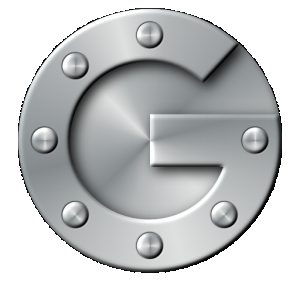
-
Programm im Handy als Token ("Soft-Token")
-
Initiative for Open Authentication
-
TOTP Algorithmus, RFC 6238
-
Keine Netzwerkverbindung benötigt
-
"Google Authenticator" im Google Play Store
-
Auch für iGeräte verfügbar
-
http://www.dynalogin.org - kompatible Alternative
Wie funktioniert TOTP
-
UTC Zeit ist gleich rund um die Welt
-
Secret + UTC = Zugangscode
Wie funktioniert TOTP
-
UTC Zeit ist gleich rund um die Welt
-
Secret + UTC = Zugangscode
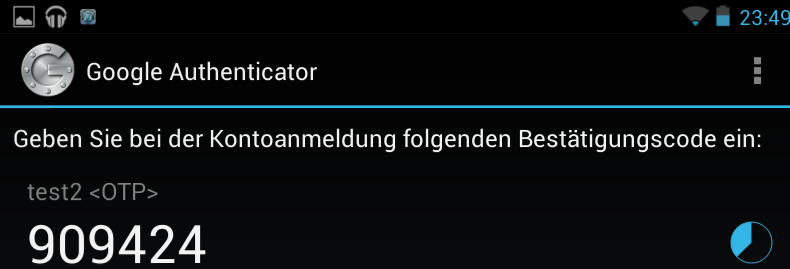
Wie funktioniert TOTP
-
UTC Zeit ist gleich rund um die Welt
-
Secret + UTC = Zugangscode
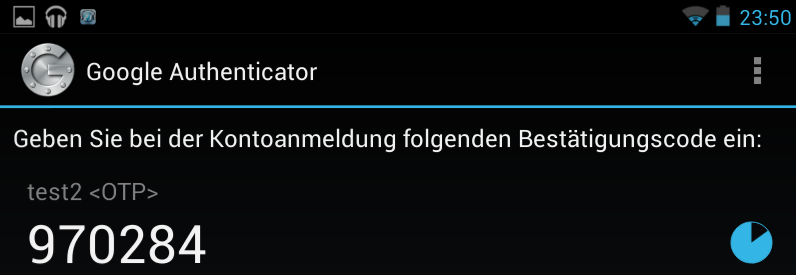
Wie funktioniert TOTP
-
UTC Zeit ist gleich rund um die Welt
-
Secret + UTC = Zugangscode
-
Secret ist äquivalent zum Zugangscode!

Workflow
-
Anmelden mit Passwort
-
Setup der Zwei-Faktor Anmeldung
-
... Später mal ...
-
Anmelden mit Passwort UND Handy
OATH für den Nutzer
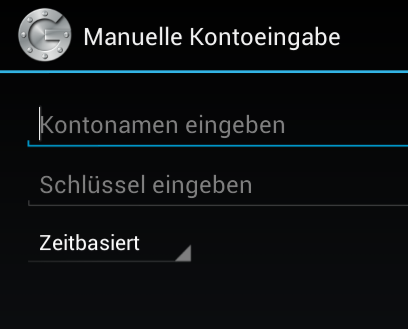
-
Setup muss einfach sein
-
Manuelle Eingabe des Shared Secret
-
Lange base32 strings (RFC 3548)
-
Beispiel:
oyztamdsmjtwymtr
OATH für den Nutzer
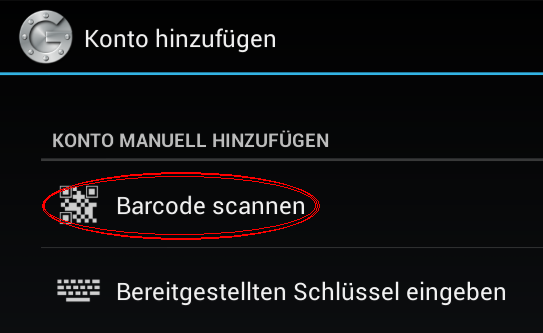
-
Setup muss einfach sein
-
Manuelle Eingabe des Shared Secret
Setup mit Google Authenticator

Besser mit QRCode
Setup mit Google Authenticator

Besser mit QRCode
CPAN hat da was.

Live Demo
API
1: # Secret pro Nutzer 2: my $auth = Auth::GoogleAuthenticator->new( 3: secret => 'test@example.com' 4: );
API
1: # Secret pro Nutzer 2: my $auth = Auth::GoogleAuthenticator->new( 3: secret => 'test@example.com' 4: ); 5: print "Registration key " . $auth->registration_key() . "\n";
API
1: # Secret pro Nutzer 2: my $auth = Auth::GoogleAuthenticator->new( 3: secret => 'test@example.com' 4: ); 5: print "Registration key " . $auth->registration_key() . "\n"; 6: print "Expected OTP value " . $auth->totp() . "\n";
API
1: # Secret pro Nutzer 2: my $auth = Auth::GoogleAuthenticator->new( 3: secret => 'test@example.com' 4: ); 5: print "Registration key " . $auth->registration_key() . "\n"; 6: print "Expected OTP value " . $auth->totp() . "\n"; 7: 8: my $verified = $auth->verify( $user_input ) 9: ? 'verified' 10: : 'not verified'; 11: print "$verified\n";
Demo
Vergleich API / Anwendung
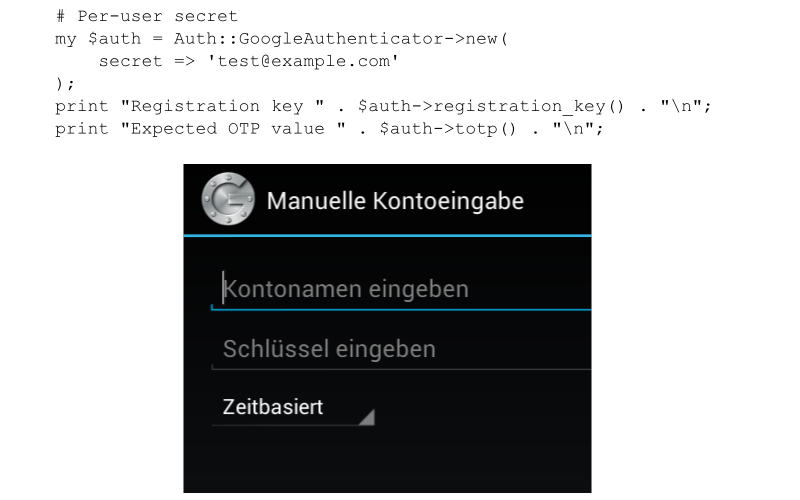
Vergleich API / Anwendung
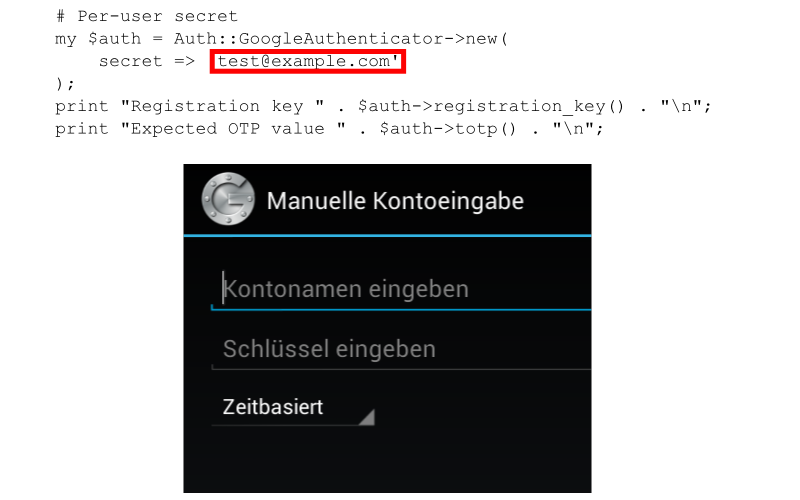
Vergleich API / Anwendung
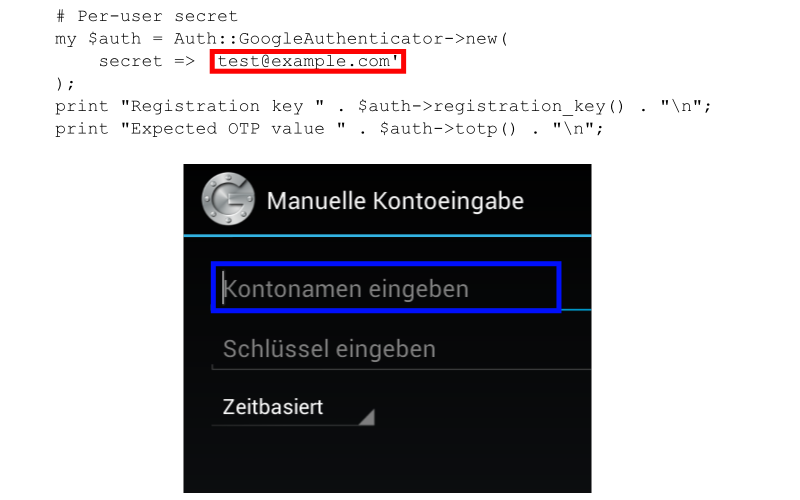
Vergleich API / Anwendung
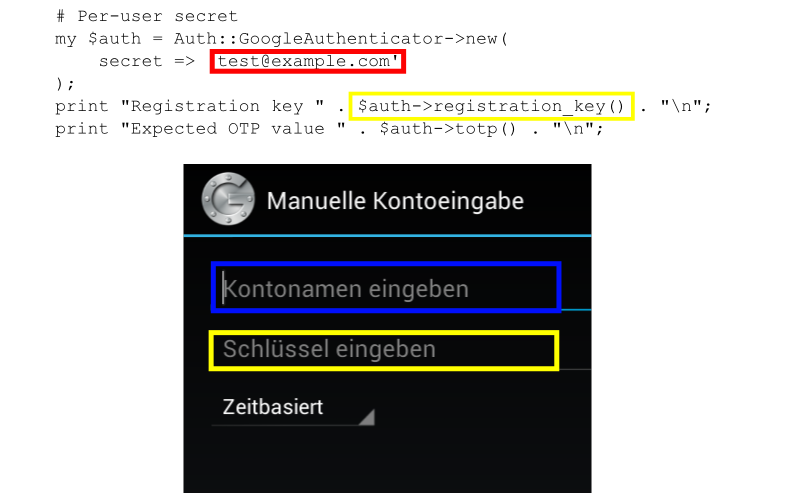
Vergleich API / Anwendung
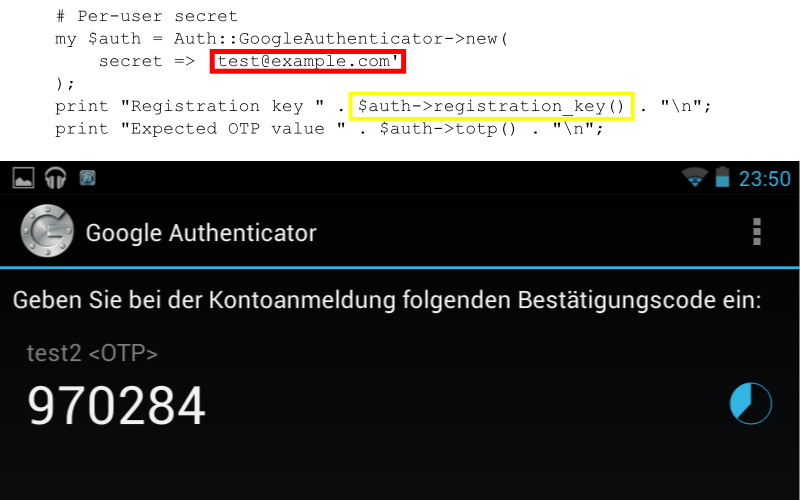
Vergleich API / Anwendung
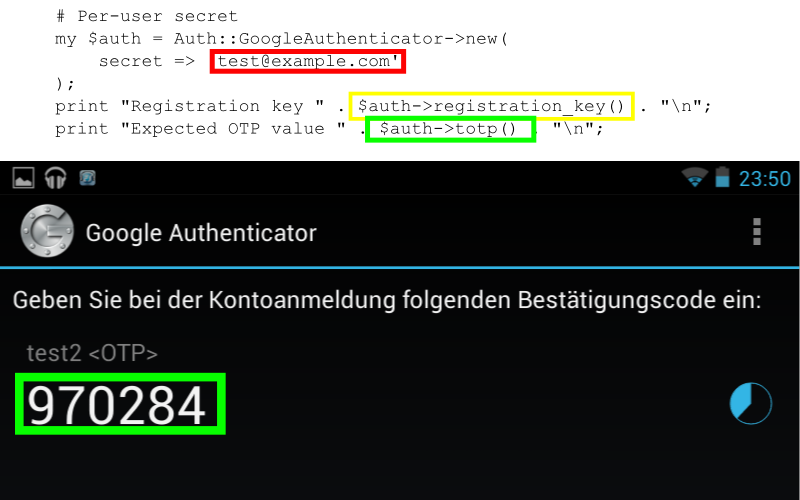
API
1: ->registration_url( $label, $type )
Erzeugt die otpauth:// URL
API
1: ->registration_url( "test2 <OTP>" )
Erzeugt die otpauth:// URL
1: my $au=Auth::GoogleAuthenticator->new(
2: secret=>'test@example.com'
3: );
4: print $au->registration_url('test2 <OTP>')
API
1: ->registration_url( "test2 <OTP>" )
Erzeugt die otpauth:// URL
1: my $au=Auth::GoogleAuthenticator->new(
2: secret=>'test@example.com'
3: );
4: print $au->registration_url('test2 <OTP>')
5:
6: otpauth://totp/test2 <OTP>?secret=orsxg5camv4gc3lqnrss4y3pnu
API
1: ->registration_url( "test2 <OTP>" )
Erzeugt die otpauth:// URL
1: print $au->registration_url('test2 <OTP>')
2:
3: otpauth://totp/test2 <OTP>?secret=orsxg5camv4gc3lqnrss4y3pnu

Gedanken zur Sicherheit
-
Secret ist Passwort-äquivalent
-
Hashing nicht möglich
-
RFC 6238 hat keine Umgangshinweise für das Secret
-
Secret-Wechsel ist leicht
-
Immer zweiten Mechanismus (gehashtes Passwort)
-
Zeitlimit für Zweifaktor-Sessions
Sicherheit durch Kombination
1: Kennwort TOTP 2-Faktor
Sicherheit durch Kombination
1: Kennwort TOTP 2-Faktor 2: 3: Austausch
Sicherheit durch Kombination
1: Kennwort TOTP 2-Faktor 2: 3: Austausch Mittel
Sicherheit durch Kombination
1: Kennwort TOTP 2-Faktor 2: 3: Austausch Mittel Leicht
Sicherheit durch Kombination
1: Kennwort TOTP 2-Faktor 2: 3: Austausch Mittel Leicht Leicht
Sicherheit durch Kombination
1: Kennwort TOTP 2-Faktor 2: 3: Austausch Mittel Leicht Leicht 4: 5: 6: Datenleck
Sicherheit durch Kombination
1: Kennwort TOTP 2-Faktor 2: 3: Austausch Mittel Leicht Leicht 4: 5: 6: Datenleck Schwer 7: (bcrypt)
Sicherheit durch Kombination
1: Kennwort TOTP 2-Faktor 2: 3: Austausch Mittel Leicht Leicht 4: 5: 6: Datenleck Schwer Leicht 7: (bcrypt)
Sicherheit durch Kombination
1: Kennwort TOTP 2-Faktor 2: 3: Austausch Mittel Leicht Leicht 4: 5: 6: Datenleck Schwer Leicht Schwer 7: (bcrypt)
Sicherheit durch Kombination
-
Google - "Kennwort-Protokolle" (IMAP, POP3, ...) umgehen Zwei-Faktor
-
EverNote - Direkte Links zu Daten umgehen Zwei-Faktor
-
...
Umrüsten auf Zweifaktor
-
Alles umrüsten (Google!)
-
Kennwortreset bzw. Handyverlust?!
-
Ansatz: 3 Master-Reset Kennwörter ausdrucken (PUK)
Relevante Module
-
Auth::GoogleAuthenticator verwendet
-
Authen::OATH
-
Imager::QRCode
-
Dancer
Beispielcode
"Google Authenticator" im Google Play Store
http://code.google.com/p/google-authenticator/
Auch für iGeräte verfügbar
Der Beispielcode ist online auf CPAN in
Auth::GoogleAuthenticator
http://www.dynalogin.org - noch ein Android Soft-Token
Danke
"Google Authenticator" im Google Play Store
http://code.google.com/p/google-authenticator/
Auch für iGeräte verfügbar
Der Beispielcode ist online auf CPAN in
Auth::GoogleAuthenticator
http://www.dynalogin.org - noch ein Android Soft-Token
Fragen?
Max Maischein (corion@cpan.org)